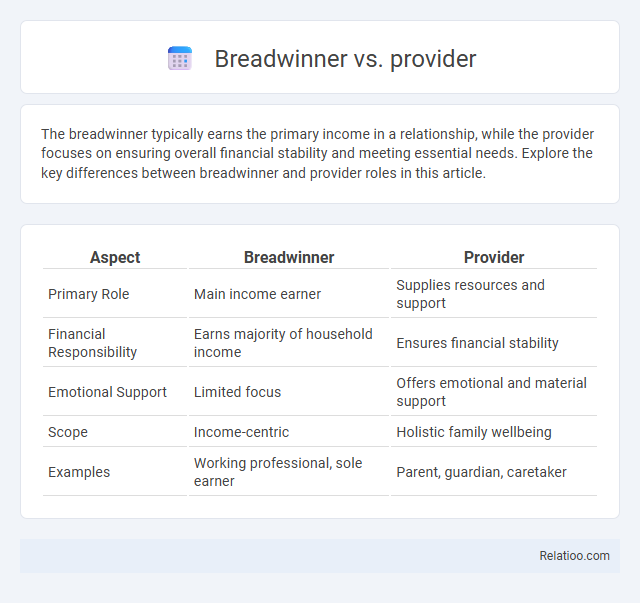The breadwinner typically earns the primary income in a relationship, while the provider focuses on ensuring overall financial stability and meeting essential needs. Explore the key differences between breadwinner and provider roles in this article.
Table of Comparison
| Aspect | Breadwinner | Provider |
|---|---|---|
| Primary Role | Main income earner | Supplies resources and support |
| Financial Responsibility | Earns majority of household income | Ensures financial stability |
| Emotional Support | Limited focus | Offers emotional and material support |
| Scope | Income-centric | Holistic family wellbeing |
| Examples | Working professional, sole earner | Parent, guardian, caretaker |
Defining Breadwinner and Provider
The breadwinner is typically defined as the primary earner in a household who contributes the largest share of income, ensuring financial stability. A provider encompasses broader responsibilities, not only supplying income but also meeting emotional and physical needs within the family. While the breadwinner focuses mainly on economic support, the provider integrates both financial support and caregiving roles.
Historical Origins of the Breadwinner Role
The historical origins of the breadwinner role date back to the industrial revolution when men were primarily responsible for earning income to support their families. This societal expectation positioned the breadwinner as the key financial provider, distinguishing them from other household roles focused on caregiving or domestic duties. Understanding this context helps you appreciate how the breadwinner concept has evolved alongside shifting economic and social dynamics.
The Provider Concept: Beyond Financial Support
The Provider concept extends beyond mere financial support by encompassing emotional stability, nurturing, and household management responsibilities essential for family well-being. Unlike the traditional Breadwinner role, which primarily focuses on earning income, the Provider ensures a balanced allocation of resources, care, and attention that fosters long-term family cohesion. This holistic approach integrates economic contributions with psychological and social support, reinforcing the family's overall resilience and growth.
Gender Roles and Societal Expectations
The terms breadwinner, provider, and caretaker reflect distinct gender roles and societal expectations that vary across cultures and time. Traditionally, the breadwinner is perceived as the primary income earner, often associated with men, while the provider extends support beyond finances to emotional and household needs, challenging rigid gender norms. Modern dynamics increasingly recognize shared responsibilities, with women and men embracing both breadwinner and provider roles, reshaping societal definitions of gender and family roles.
Emotional vs. Financial Contributions
Breadwinner, provider, and caregiver each represent different roles in a household, emphasizing various types of contributions. The breadwinner primarily supports your family financially, ensuring economic stability, while the provider may offer both financial support and emotional nurturing. Emotional contributions such as empathy, communication, and support are essential to balance the financial responsibilities, fostering a healthier and more connected family dynamic.
Modern Shifts in Household Dynamics
Modern shifts in household dynamics reveal evolving roles where the breadwinner traditionally refers to the primary income earner, while the provider emphasizes supporting overall family needs beyond finances. Increasingly, dual-income households blur these distinctions, highlighting shared responsibilities in earning and caregiving. Data from contemporary family studies show a significant rise in equitable role distribution, challenging the conventional breadwinner-provider dichotomy.
Impact on Relationships and Family Life
The roles of breadwinner, provider, and caregiver each uniquely impact relationships and family life by shaping emotional dynamics and responsibilities; the breadwinner typically bears financial pressure, which can affect stress levels and communication patterns within the household. Providers contribute not only economically but also by fulfilling emotional and practical needs, fostering a balanced partnership that supports both individual and family well-being. Understanding your specific role and its implications helps improve empathy and collaboration, strengthening the foundation of your relationships and family cohesion.
Challenges Faced by Breadwinners and Providers
Breadwinners and providers both shoulder significant financial responsibilities, but breadwinners often face the challenge of sole income pressure, creating stress about job security and financial stability. Providers may encounter difficulties balancing work and family obligations, as they support not only financially but also emotionally, leading to potential burnout and strained relationships. Understanding your role in these dynamics helps address these challenges with better support systems and work-life balance strategies.
Redefining Success in Today’s Households
Breadwinner, provider, and breadwinner roles are evolving to reflect diverse contributions within modern households, emphasizing shared responsibilities over traditional income sole reliance. Your household success is increasingly defined by balanced caregiving, emotional support, and financial input, challenging outdated stereotypes of success. This shift highlights the importance of valuing multiple forms of support to achieve holistic family well-being and personal fulfillment.
Moving Toward Partnership and Balance
Moving toward partnership and balance involves redefining roles beyond the traditional breadwinner and provider labels to foster shared responsibilities and mutual support. Your relationship flourishes when both partners contribute economically and emotionally, creating equilibrium that recognizes each person's strengths and needs. Prioritizing communication and cooperation promotes a partnership where income generation and caregiving duties are balanced effectively.

Infographic: Breadwinner vs Provider
 relatioo.com
relatioo.com